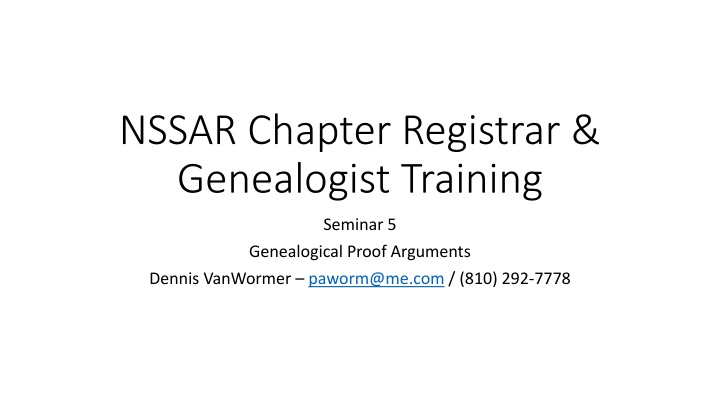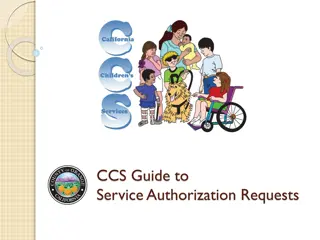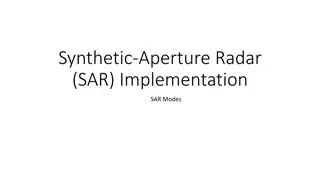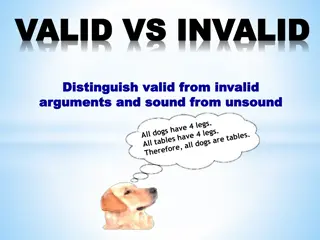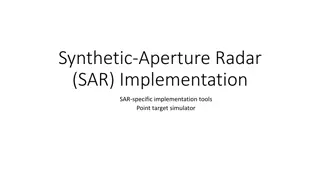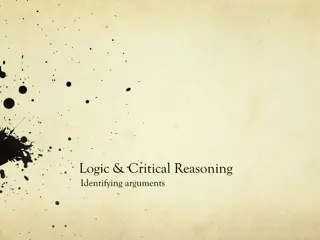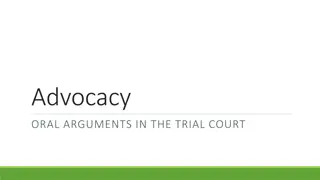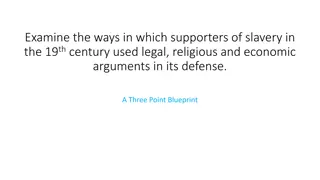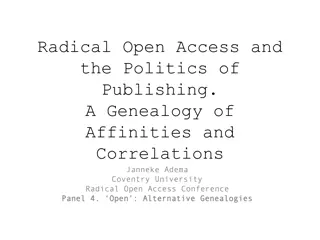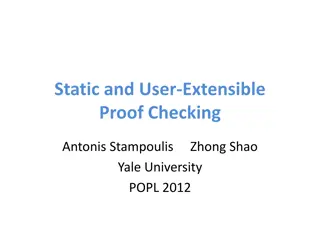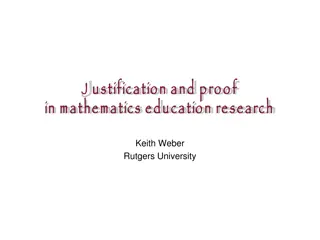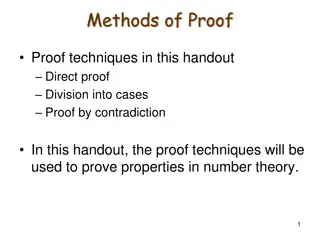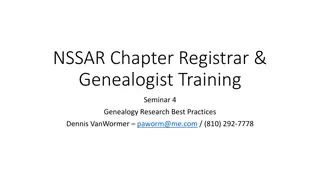Genealogical Proof Arguments and SAR Standard of Proof
This detailed content covers the definitions and components of genealogical proof arguments, proof summaries, and the SAR standard of proof. It explains the importance of evidence quality, source citations, and analysis in establishing acceptable genealogical conclusions for SAR membership applications. Examples, policy guidelines, and the use of DNA evidence in proof arguments are included.
Uploaded on Sep 28, 2024 | 3 Views
Download Presentation

Please find below an Image/Link to download the presentation.
The content on the website is provided AS IS for your information and personal use only. It may not be sold, licensed, or shared on other websites without obtaining consent from the author.If you encounter any issues during the download, it is possible that the publisher has removed the file from their server.
You are allowed to download the files provided on this website for personal or commercial use, subject to the condition that they are used lawfully. All files are the property of their respective owners.
The content on the website is provided AS IS for your information and personal use only. It may not be sold, licensed, or shared on other websites without obtaining consent from the author.
E N D
Presentation Transcript
NSSAR Chapter Registrar & Genealogist Training Seminar 5 Genealogical Proof Arguments Dennis VanWormer paworm@me.com / (810) 292-7778
Genealogical Proof Arguments Genealogical Proof Arguments Definitions SAR Standard of Proof Genealogical Proof Argument Flow of a Proof Argument Genealogical Proof Argument Policy Using a Proof Argument or Proof Summary Proof Argument Using DNA Evidence Citing a Proof Argument Citing a DNA Proof Argument Proof Argument Examples from APG Successful MISSAR Proof Arguments Questions & Answers
Definitions Definitions Genealogy Standards: 50th Anniversary Edition, Turner Publishing Company Genealogy Standards: 50th Anniversary Edition, Turner Publishing Company Proof A documented statement, summary, or argument that explains or shows why a conclusion is proved; also, a description of a genealogical conclusion that is acceptable because it meets the Genealogical Proof Standard's five components Proof Argument A documented narrative that explains why a genealogist's answer to a complex genealogical problem should be considered acceptable Proof Summary A documented narrative or list stating facts that support or lead to an acceptable conclusion Officially, a proof argument is for a more complex problem; a proof summary is for a less complex problem. Used interchangeably by SAR.
SAR Standard of Proof SAR Standard of Proof (GCP, 30 Sep 2022, Section 3.0000) (APG, 30 Sep 2022, p 37 ) (GCP, 30 Sep 2022, Section 3.0000) (APG, 30 Sep 2022, p 37 ) Genealogical conclusions as stated on applications for membership in the SAR, including conclusions about Revolutionary service, are expected to meet the Genealogical Proof Standard. On this standard, acceptable genealogical conclusions are based on: a reasonably exhaustive search of available evidence compilation of complete and accurate source citations an analysis and correlation of the collected evidence resolution of any conflicting evidence presentation of a soundly reasoned, coherently written conclusion. (GCP) This is the rule. Therefore, evidence must be sufficiently convincing to the NSSAR Genealogy Staff before proof is accepted, and the quality of evidence is a key element. Sources are either original or derivative. Information found in sources may be primary and/or secondary. Evidence may be direct or indirect. (APG)
Genealogical Proof Argument Genealogical Proof Argument (APG, (APG, 30 Sep 2022 30 Sep 2022, p 37) , p 37) (GCP, 30 Sep 2022, Section 3.0000) (GCP, 30 Sep 2022, Section 3.0000) There are five requirements to be met to build a proof argument: Conduct a reasonably exhaustive search for all information that is or may be pertinent to the identity, relationship, event or situation in question; Collect and include in our compilation a complete, accurate citation to the source or sources of each item of information we use; Analyze and correlate the collected information to assess its quality as evidence; Resolve any conflicts caused by items of evidence that contradict each other or are contrary to a proposed (hypothetical) solution to the questions; and Arrive at a soundly reasoned, coherently written conclusion. Outside of SAR this is referred to as the Genealogical Proof Standard by the Board for Certification of Genealogists (and others)
Flow of a Proof Argument Flow of a Proof Argument SOURCES INFORMATION EVIDENCE ANALYSIS PROOF Or in words: SOURCES provide INFORMATION from which may be identified EVIDENCE which may be ANALYZED to draw a conclusion that may be considered PROOF. (Adapted from chart found in Genealogy Standards: 50thAnniversary Edition)
Genealogical Proof Argument Policy Genealogical Proof Argument Policy (GCP, 30 Sep 2022, Section 3.2000) (GCP, 30 Sep 2022, Section 3.2000) 3.2000 Genealogical Proof Arguments. Genealogical proof arguments are necessary when the evidence, on its own, fails to lead to a clear conclusion. The proof argument consists of a detailed, written explanation of the evidence and reasoning used to reach a conclusion and is often necessary when: there is conflicting evidence (see GCP 3.2001) there is an identity problem (see GCP 3.2002) the conclusion requires indirect evidence (see GCP 3.2003b), or the applicant wishes to clarify a conclusion (proof summary) The existence of genealogical proof arguments must be listed in the appropriate section of the application with the headings Reference or Proof of Service . In addition, both the genealogical proof argument and the supporting proofs should be provided with the documentation.
Using a Proof Argument or Proof Summary Using a Proof Argument or Proof Summary (APG, 20 Sep 2022, p 20) (APG, 20 Sep 2022, p 20) The process requires using several independent documents, none of which in themselves are sufficient but may build a case that proves the lineage or service. A proof argument may take many forms. See Appendix E for examples of proof arguments. Proof arguments should include the following elements: 1) state the problem, 2) state why the proof argument is needed, 3) a listing of the included documents, 4) analysis of each document used and how it fits in resolving the problem, and 5) a conclusion based on the analysis. NOTE: Submit a separate proof argument for each link that is not established using acceptable evidence or in situations where there is conflicting evidence.
Proof Argument Using DNA Evidence Proof Argument Using DNA Evidence (GCP, 30 Sep 2022, Section 5.4005 & 5.4006) (GCP, 30 Sep 2022, Section 5.4005 & 5.4006) 5.4005 DNA. DNA evidence can only be used as one element of a genealogical proof argument that includes additional conventional proof of the lineage. None of the major tests -- Y-DNA, autosomal DNA, mitochondrial DNA, or X-DNA alone can prove descent from a specific individual. . . . However, by combining the various tests and using techniques to support predicted relationships, coupled with traditional evidence, a case can be built to demonstrate relationships. 5.4006 Policy with Respect to the Use of DNA Evidence. (A)ny use of Personally Identifiable Information (PII) of living people for DNA evidence will require affirmative consent from those individuals. DNA proofs are limited to generations one to two or generations two to three only.
Proof Argument Using DNA Evidence Proof Argument Using DNA Evidence (APG, 30 Sep 2022, p 18 (APG, 30 Sep 2022, p 18- -19) 19) SAR allows the use of DNA evidence only as part of a genealogical proof argument or proof summary that also requires traditional evidence to prove the lineage. DNA proof arguments/summaries are limited to proving lineage from generation one to two or generation two to three only. In addition, only one DNA proof argument is allowed on a given application. DNA evidence indicating a relationship must be accompanied by consent forms available on www.sar.org in the Genealogy Resources section. AT THIS TIME, THE SAR WILL ONLY ALLOW THE USE OF COURT-ORDERED PATERNITY/MATERNITY DNA TESTS OR AUTOSOMAL DNA TESTS AS PART OF A GENEALOGICAL PROOF ARGUMENT FOR PROVING THE BIOLOGICAL LINK BETWEEN PARENT AND CHILD FOR GENERATIONS 1 TO 2 OR GENERATIONS 2 TO 3.
Citing a Proof Argument Citing a Proof Argument The policy for citing a proof argument changed recently: GCP, 5 Mar 2022, Section 3.2000: Genealogical proof arguments should be provided with the documentation rather than entered on the application. GCP, 25 Jul 2022, Section 3.2000: The existence of genealogical proof arguments must be listed in the appropriate section of the application with the headings Reference or Proof of Service . Example of proof argument citation provided in Appendix A of new APG (listed in Reference Section for Generation 7): Proof Summary: Cumberland Co., PA, Deed Book 1, p. 132; Mifflin Co., PA, Estate Record #2438-LWT of Philip Kilmer; Mifflin Co., PA, Deed Book N, p. 476-477 (gen 6); Mifflin Co., PA, Deed Book N, p. 512-514 (gen 6)
Citing a DNA Proof Argument Citing a DNA Proof Argument (APG, 30 Sep 2022, p 19) (APG, 30 Sep 2022, p 19) Confidentiality of DNA Evidence at SAR As noted above, no raw DNA evidence will be accepted by SAR for an application. Only test results and analyses from acknowledged companies or third-party tools will be accepted. Further, on the actual application, only a reference to DNA evidence will be allowed. A record copy of an approved application will be available for copying, but none of the DNA evidence (test results, third-party analyses, etc.) will be available for copying. The DNA consent forms will also not be available for copying. Citation of DNA Proof Argument/Summary on the Application In the Reference sections of both generations involved in the proof argument, the citation should be included as follows: DNA proof argument (or summary): DNA evidence, (followed by citing each piece of traditional evidence, unless the applicant specifically requests certain documents not be listed)
Proof Argument Examples from APG Proof Argument Examples from APG (APG, 30 Sep 2022, pp 41 (APG, 30 Sep 2022, pp 41- -49) 49) 1. A death certificate is incorrect in naming of the spouse and the parents of the decedent. The bloodline went through Emma Rixon and Mary Jane Cardinell. This proof summary was successfully used to support SAR, C.A.R. and Mayflower Society applications. Photocopies of the supporting documents were included with the packages. (p 41-42) 2. The only direct source found to support a parent/child link in the bloodline is an undocumented family history. This proof summary was successfully used to support a SAR application. Photocopies of the supporting documents were included with the packages. (p 43)
Proof Argument Examples from APG Proof Argument Examples from APG (APG, 30 Sep 2022, pp 41 (APG, 30 Sep 2022, pp 41- -49) 49) 3. This proof argument uses several undocumented sources in conjunction with some documented sources to build a case for two generational links. Problem: Patriot ancestor Joseph Coddington mentions his son John Coddington in his will. John Coddington changed his name to John Corrington. The following proved that John Corrington and John Coddington were the same person. (p 44) 4. This is an analysis used on an SAR Supplemental, employing Civil War letters and later land records to prove an otherwise undocumented father-daughter relationship. Photocopies and transcriptions of two letters and the land records were provided. (p 45-47)
Proof Argument Examples from APG Proof Argument Examples from APG (APG, 30 Sep 2022, pp 41 (APG, 30 Sep 2022, pp 41- -49) 49) 5. This is an example showing a proof argument to distinguish between persons of the same name. Proof that the Mary Jenkins (gen. 4) who married William Henry Webb is the daughter of Lewis Jenkins (gen. 5). Problem: There are three contemporary Mary Jenkins who lived and married in Union Co. Ohio between 1856 and 1863. (pp 48) 6. Genealogy Policy, Sec. 4.4000 allows indirect evidence in support of service. The following is an example of a proof argument using indirect evidence to establish patriotic service through the signing of an Oath of Allegiance in the absence of any record of the oath. (p 49)
Successful MISSAR Proof Argument Successful MISSAR Proof Argument (Diana Stevers & Dennis VanWormer) (Diana Stevers & Dennis VanWormer) Proof Argument: Generation 5 6: Isaiah Wilcoxson/Wilcox to Samuel Wilcoxson Proof that the DAR-proven Isaiah Wilcoxson/Wilcox (gen. 5) b. 1796 in NC, son of Samuel (gen. 6), is the same man named Isiah Wilcoxson/Wilcox (gen. 5) who fathered and raised a 2nd family in KY with Sally Mullins, including son Isiah Wilcox (gen. 4), b. 1864 in KY. Problem: There are two men named Isaiah Wilcoxson/Wilcox born 1796 in North Carolina and died 1870 in Carter Co. Kentucky. (DAR RC#1000596 Samuel Wilcoxson uses a lineage with the NC wife of Isaiah, while this application uses a lineage with the KY wife of Isaiah. Need to prove that the husband of the second wife is the same man as the first wife s husband.) Evidence: The death certificate of Isiah Wilcox (gen. 4), d. 1943 in Kentucky, names his parents Isaiah Wilcox (gen. 5), b. NC and Sally Mullins; his death certificate also shows he was born 1864 in Willard, KY. A review of the town history of Willard shows this town was and is in Carter Co. KY, beginning in the mid-1800 s. This death certificate demonstrates Isaiah Wilcoxson/Wilcox, father of Isiah Wilcox, emigrated from NC to Carter Co. KY sometime before 1864. The 1870 census for Precinct No. 5, Carter Co. KY records Sarah Wilcox as head of household living with 7 children, including Andrew (14 yrs), Hiram (11 yrs) and Isiah (5 yrs). A man named Isaiah Wilcox is found in the 1870 Mortality Schedule for Precinct No. 5, Carter Co. KY, listed as died in during 1870, aged 74 years old and born in NC. Both records are recorded in the same year and location, and the ages of the youngest children living In Sarah s household make it reasonable to conclude that the Isaiah Wilcox listed in the 1870 Carter Co. KY Mortality Schedule is Isaiah Wilcoxson/Wilcox b. 1796 in NC, the same man as the father named in the death certificate of Isiah Wilcox, born and died in Carter Co. KY, 1864-1943. (continued on next slide)
Successful MISSAR Proof Argument Successful MISSAR Proof Argument (Diana Stevers & Dennis VanWormer) (Diana Stevers & Dennis VanWormer) The 1860 census in Pike Co. KY shows a couple named Izersah Wilcox, b. circa 1797, living with Sarah and five children, including a 12-year-old daughter named Duecsune and 2 young boys, A. J. (6 yrs) and Hiram (4 yrs). A. J. and Hiram are the same children also listed in the 1870 census. Given the names, ages, location and family group, it is reasonable to conclude Duecsune, A. J. and Hiram are the children of Izersah and Sarah Wilcox. A review of historical county maps in 1860 show Pike Co. and Carter Co. to be in close proximity to each other near the Eastern border of KY. The marriage certificate of Delcena Wilcox Gilbert in Carter Co. KY and the death certificates of Andrew J. and Hiram Wilcox all report their parent s names as Isaiah Wilcox and Sarah/Sally Mullins, which confirms the children listed in the 1860-1870 census are siblings of Isiah Wilcox, 1864-1943, and the children of Isaiah Wilcoxson/Wilcox and Sarah Mullins. Two of these vital records record NC as the birthplace of their father, Isaiah Wilcoxson/Wilcox. The 1850 census in Russel Co. VA shows a man named Isaiah Wilcox, age 66 born in NC, living with a woman named Sarah Mullins, age 26 and Dulcena Mullins, a 2-year-old girl. The compilation and analysis of the 1850-1870 census records coupled with this family s vital records show Isaiah Wilcoxson/Wilcox s migration from NC pre-1850, starting a family in VA by 1850 with a woman named Sarah Mullins then moving to Carter and Pike Co. KY where he died in 1870. A search of the DAR database finds a man named Isaiah Wilcoxson/Wilcox, married to Fannie Greer in Ashe Co. NC and died in Carter Co. KY in 1879, proven as the son of Samuel Wilcoxson. The family names, dates and locations recorded for Isaiah Wilcoxson/Wilcox and Fannie Greer in DAR Record Copy #1000596 mirror the migration pattern of the man named Isaiah Wilcoxson/Wilcox married to Sarah Mullins. This DAR Record Copy shows Fannie Greer was born and lived in Ashe Co. NC until her death after 1860. It also shows her husband, Isaiah Wilcoxson/Wilcox b. 1796, migrated from Ashe Co. NC to Carter Co. KY where he died 1879 in Carter Co. KY. This same record also shows Nancy Matilda Wilcox, daughter of Isaiah Wilcoxson/Wilcox and Fannie Greer, born in Ashe Co. NC and married to Solomon Williams Mullins 1848 in Pike Co. KY, where she remained until her death in 1881. (continued on next slide)
Successful MISSAR Proof Argument Successful MISSAR Proof Argument (Diana Stevers & Dennis VanWormer) (Diana Stevers & Dennis VanWormer) In 1860, while Isaiah Wilcoxson/Wilcox was living with Sarah Mullins and their children in KY, Fanny Wilcox is found living in the 1860 Census in Ashe Co. NC. She is listed as the head of household, age 60 years, living with only one other person: a young female named Ann. Since this census record matches the name, dates and locations recorded on the DAR Record Copy for Fannie Greer, it is reasonable to conclude the Fanny Wilcox found in the 1860 cen. Ashe Co. NC is the woman named Fannie Greer accepted in the DAR Record Copy as the proven wife of Isaiah Wilcoxson/Wilcox, son of Samuel Wilcoxson. The Civil War Widows Pension file shows the affidavit of Nancy Matilda Wilcox, widow of Solomon Williams Mullins, in Pike Co. KY. This record also shows Isaiah Wilcoxson/Wilcox and Sarah Mullins, residents of Pike Co. KY, signed an affidavit on 5 Mar 1864 to swear to their knowledge of Nancy s children with Solomon Williams Mullins and testify they paid for the minister who performed the marriage ceremony for Nancy and her husband in 1848 at Pike Co. KY. While there is no direct relationship mentioned in this record, the fact Isaiah and Sarah would pay for this marriage ceremony infers there was a close family relationship. Further, the DAR Record Copy proves Nancy Matilda Wilcox is both the wife of Solomon Williams Mullins and the daughter of Isaiah Wilcoxson/Wilcox, b. 1796 in NC and died in Carter Co. KY. This pension benefit record matches the name, dates, locations and relationships proven on the DAR Record Copy for Nancy Matilda Wilcox, daughter of Isaiah Wilcoxson/Wilcox and Fannie Greer. It is reasonable to conclude the Nancy Matilda Wilcox in the pension benefit record is the same woman proven as the daughter of Isaiah Wilcoxson/Wilcox, son of Samuel Wilcoxson. Special note: A review of historical county maps 1850-1870 in Russell Co. VA, Pike Co. KY and Carter Co. KY show these 3 counties are very close in proximity to each other, near the shared border between Kentucky and Virginia. Conclusion As a result, the conclusion can be made that Isaiah Wilcoxson, b. 1796, DAR-proven son of Samuel Wilcoxson, left Ashe Co., North Carolina and 1st wife Fannie (nee Greer) Wilcoxson sometime before 1850 and raised a 2nd family with Sarah Mullins and their children in Kentucky, including his son Isiah Wilcox (gen. 4), 1864-1943. Therefore, the father of Isiah Wilcox (gen. 4), 1864-1943 is Isaiah Wilcoxson/Wilcox (gen. 5), who is the son of DAR-proven Samuel Wilcoxson (gen. 6) as recorded in DAR Record Copy #1000596.
Successful MISSAR Proof Argument Successful MISSAR Proof Argument (Robert Eager & Dennis VanWormer) (Robert Eager & Dennis VanWormer) Proof Argument that Elias Stephens/Stevens (Gen 8) was a Revolutionary War Patriot Problem: There is no direct evidence that the Elias Stephens/Stevens in Generation 8 who was the father of Elisha Stephens in Generation 7 was also the Elias Stephens/Stevens who served as a private in Captain David Beebe s Company of Colonel Roger Enos Regiment of Connecticut State Troops in the Revolutionary War. Summary of Findings: Elias Stephens/Stevens was born 06 June 1755 in Canaan, CT. (birth record, Connecticut Town Birth Records pre-1870, Barbour Collection, p 84) (Elijah Stephens Family Bible, 1828) Elias Stephens/Stevens and Rhoda Phelps were the parents of Elisha Stephens and Elijah Stephens, along with other children. Elisha was born on 21 October 1787. (Elijah Stephens Family Bible, 1828) Elias Stephens/Stevens of Canaan enlisted as a minute man in the regiment of Roger Enos in April 1778. (Public Records of Connecticut 1779, pp 319-320) Elias Stephens/Stevens was listed on the muster roll of Captain David Beebe s Company in Colonel Roger Enos Regiment of Connecticut State Troops on 28 September 1778. (United States Revolutionary War Rolls, 1775-1783) (continued on next slide)
Successful MISSAR Proof Argument Successful MISSAR Proof Argument (Robert Eager & Dennis VanWormer) (Robert Eager & Dennis VanWormer) An extensive search of Connecticut records has found no other Elias Stephens/Stevens living in the Canaan area during the timeframe of the Revolutionary War. Records searched include: Canaan, Connecticut Land Records, 1737-1935 Connecticut Town Marriage Records, pre-1870 (Barbour Collection) Hale Collection of Connecticut Cemetery Records Church Records of South and East Canaan, Connecticut, 1769-1870 Connecticut, U.S., Wills and Probate Records, 1609-1999 Find A Grave (for Litchfield County, Connecticut USA) No other Elias Stephens/Stevens were found that served in the Revolutionary War who were from the Canaan area. Records searched included: United States Revolutionary War Rolls, 1775-1783 (NARA M246) The Record of Connecticut Men in the Military and Naval Service During the War of the Revolution 1775-1783, Vol. I-III Analysis: The lineage from the applicant to Elias Stephens/Stevens is definitively proven from his record copy and the family Bible. The evidence provided for Proof of Service also clearly shows that there was an Elias Stephens/Stevens from Canaan who served in the Connecticut State Troops in 1778. Only one person named Elias Stephens/Stevens was born in Canaan and was living in the Canaan area during the timeframe of the Revolutionary War. No other Elias Stephens/Stevens were found that served in the Revolutionary War and that were from the Canaan area. Conclusion: The Elias Stephens/Stevens from Canaan who served in Captain David Beebe s Company in Colonel Roger Enos Regiment of Connecticut State Troops was the same Elias Stephens/Stevens who was married to Rhoda Phelps and the father of Elisha Stephens (and Elijah Stephens).
Successful MISSAR Proof Argument Successful MISSAR Proof Argument DNA (Barbara Reardon) (Barbara Reardon) DNA PROOF ARGUMENT for Sons of the American Revolution (SAR) application of MICHAEL JOHN JONES (Gen 1) relationship to ROBERT SUMMERS YOUNG (Gen 2) Michael John Jones (Gen 1) was born on 28 May 1947, in Jefferson County, Kentucky. His birth certificate lists his mother s name as Irene Jones, age 22. Father s name is not listed. (Blood lineage for application is through father.) Michael took several DNA tests including 23 & Me. The results of the DNA test at 23 & Me resulted in identification of two half siblings (shared DNA 24%). Their names are Robert Young and Sally Young. Sally s birth name is Sara. Applicant advises that 23 & Me tests do not have kit numbers. Per birth certificate, Robert Summers Young Jr was born on November 7, 1944, in Lexington, Fayette County, Kentucky. His father is listed as Robert Summers Young and mother is listed as Mildred Ballard Wheeler. Per birth certificate, Sara Lloyd Young was born on July 17, 1951, in Lexington, Fayette County, Kentucky. Her father is listed as Robert Summers Young and mother is listed as Mildred Ballard Wheeler. Since Michael s mother is listed as Irene Jones, and Robert and Sara s mother is listed as Mildred Wheeler; and the 24% shared DNA indicates that Robert and Sally/Sara are half siblings to Michael, the conclusion is that Robert Summers Young (Gen 2) is the father of all 3 siblings. The ages of all 3 are consistent with their being siblings as opposed to aunt/uncle. Attachments: Application Consent DNA Form, Michael John Jones; b/c and Match Consent Forms, Robert Summers Young; b/c and Match Consent Forms, Sara (Sally) Lloyd Young; Screenshot: 23 & Me (showing Sally and Robert Young matches to Michael John Jones); Screenshot: Family Tree Y-DNA test screenshot (showing match between Michael Jones and Robert Young); Screenshot: Ancestry.com DNA (showing Sally Young match to Michael Jones)
